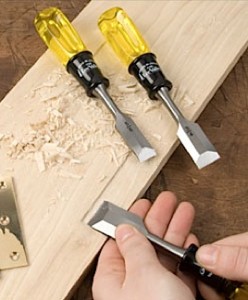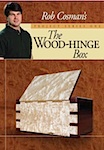We may receive a commission when you use our affiliate links. However, this does not impact our recommendations.
 In the short video posted last Thursday (1/30/2014), Christopher Schwarz talks about chisels. At the tail end of the clip, he talks about butt chisels where he mentions that these chisels are shorter and have great balance when knocking out dovetail waste, but you use a bench chisel for that, too.
In the short video posted last Thursday (1/30/2014), Christopher Schwarz talks about chisels. At the tail end of the clip, he talks about butt chisels where he mentions that these chisels are shorter and have great balance when knocking out dovetail waste, but you use a bench chisel for that, too.
So why do we have butt chisels? The term is said to originate from the carpenter trade where short chisels have a specific purpose. Before I divulge that purpose, I’ll share another story.
A little girl asked her mother why she cuts the ends off her holiday hams. Mom told the little girl to ask her grandmother. When asked, grandmother told the girl to ask great-grandmother. (Obviously this was passed down through generations.) Great-grandmother’s answer was simple: She cut the ends off the ham so it could fit into the only pan she had available.
With that story in mind, butt chisels, such as those shown in the above photo from Lee Valley, are often used in the carpentry to cut the gain for door hinges or butt hinges (hinges that are on the side of the door that abuts the frame).  With the door jambs (the frame to which the door attaches and swings) in place in the wall, regular-length chisels could not fit between the floor and lowest hinge or between the upper hinge and the top of the door frame. At the right, you can see the difference in lengths with a comparison of Veritas chisels. If you could wedge a regular-length chisel into position, there would be no room to swing a mallet or hammer. As a result, shorter chisels came to be used by carpenters for the specific purpose of installing butt hinges. Hence the name butt chisels.
With the door jambs (the frame to which the door attaches and swings) in place in the wall, regular-length chisels could not fit between the floor and lowest hinge or between the upper hinge and the top of the door frame. At the right, you can see the difference in lengths with a comparison of Veritas chisels. If you could wedge a regular-length chisel into position, there would be no room to swing a mallet or hammer. As a result, shorter chisels came to be used by carpenters for the specific purpose of installing butt hinges. Hence the name butt chisels.
 With that same reasoning, we have butt mortise planes (Lie-Nielsen’s example is shown in the left-hand photo). This plane was designed so the distance from the front edge of the blade to the rear edge of the plane is short enough to fit above the top hinge or below the bottom hinge. And the open throat allows the user to look through the plane directly at the area of work; it’s way easy to see the start/stop points as you work. Notice there are knobs on both ends of the plane. This is for better control, and it’s possible to push or pull the tool depending on how the tool is used.
With that same reasoning, we have butt mortise planes (Lie-Nielsen’s example is shown in the left-hand photo). This plane was designed so the distance from the front edge of the blade to the rear edge of the plane is short enough to fit above the top hinge or below the bottom hinge. And the open throat allows the user to look through the plane directly at the area of work; it’s way easy to see the start/stop points as you work. Notice there are knobs on both ends of the plane. This is for better control, and it’s possible to push or pull the tool depending on how the tool is used.
Is this how butt chisels and planes got named, or are we simply cutting the ends off of the ham?
 If you want to stay away from hinge mortises altogether, think wooden hinges. Rob Cosman’s “The Wooden-Hinge” is just the ticket. Rob works through building a nice dovetailed box, but far and away, the best technique shown is the wooden hinge. He demonstrates the process to turn any lumber into a dowel that is then transformed into a hinge. This alone is worth any funds spent on the DVD.
If you want to stay away from hinge mortises altogether, think wooden hinges. Rob Cosman’s “The Wooden-Hinge” is just the ticket. Rob works through building a nice dovetailed box, but far and away, the best technique shown is the wooden hinge. He demonstrates the process to turn any lumber into a dowel that is then transformed into a hinge. This alone is worth any funds spent on the DVD.
Here are some supplies and tools we find essential in our everyday work around the shop. We may receive a commission from sales referred by our links; however, we have carefully selected these products for their usefulness and quality.










The auto-correct on my mail program really does have it’s own mind…while I’m losing mine.
“my apologies for ready too my Chris Schwartz” was intended to read “my apologies for reading too much Chris Schwartz”
Maybe we could talk about the “nickels” that Chris espouses…are they “real” or “test”?
In an older time and in a land where English is spoken, hinges were called “butts” just as a car trunk is still called a “boot”. Doesn’t make a lot of sense…except to them. Back in the early 70’s when I started as an architect, doors were specified with “pairs of butts”…usually 1 and a half pairs. Maybe that’s why you could open a door a crack…my apologies for ready too my Chris Schwartz.
So using the language at the time, it would seem logical that a butt chisel was a chisel used to work on butts, like a mortise chisel was used to work on mortises.
If one uses today’s bastardization, one could,would, or should use a timber framing slick to work on butts…and it might be too small; but it would make a good noise when it fell off a certain woodworker’s bench.
Hope this helps.
What are Butt Chisels for?
For chiseling Butts of coarse! Duh!
Well Glen I can only say that my Grandfather and Grandfather, both time served carpenters and joiners, did not fit hinges the way you describe. They put the door in place in the frame, jammed it in place with an old chisel and scribed around the hinge. Then they used a butt chisel and a mallet to chop around the scribe lines. The waste was then taken out across the grain from the edge as shown in the LV photo above. No need to get anywhere near the floor or the ceiling and the whole job completed very quickly. They would not dream of using a butt plane here as there was no need for it.
However you are correct to say that butt chisels are short because they needed to be. If you try and fit butts to a door frame you will find that a longer chisel is too unwieldy particularly when reaching up for the top one or crouching down for the bottom one. A short chisel simply makes it an easier and more accurate job.
I do not know what a butt plane was used for but I suspect it was either to fit very long fancy hinges in hardwood doors, it is not practical to use it on a fitted frame, or nothing whatsoever to do with butts.